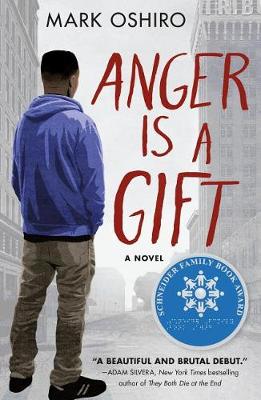Reviewed by nannah on
I tried, I really did. I wanted to keep going, because I recognize that this story is important, but it is so badly written, and the representation feels like someone running down a checklist of identities (even if the author is part of some of these communities himself). The book is obviously well loved, so I’m the outlier here.
Content warnings (from what I read):
- police brutality
- racism
- anti black racism
Representation:
- the MC is a (-n overweight?) gay black man with anxiety
- his love interest is a gay latino, I think
- a secondary character is a latina lesbian
- lots of other diverse characters are mentioned who I assume will be more central to the story, but I didn’t get that far
A police officer murdered Moss’s father six years ago and was was vilified by the media. He never got justice, despite the efforts of Moss’s activist mother. Now with debilitating anxiety from what happened then, Moss has to face the city’s racist police in his own school. When it’s announced that the officer stationed at his school will subject the kids to random locker searches, Moss and his classmates fight back.
If this book were written better, I would have few problems with it (with what I’ve read so far). And there are parts that seem crafted with a lot of care, but there’s just too few of them in this 450-page book. It’s very dialogue heavy, which isn’t a problem by itself, but I don’t think the author is very comfortable writing prose. When he does, it’s to add beats or to infodump about the diverse people around him (“There was Rosa’s home, with her three boys, Rafael, Luis, and Ramon, and her trim painted bright pink, a Big Wheel long abandoned in the front yard. The two oldest boys, Ramon and Luis, were usually in the middle of the street, kicking around a soccer ball. But last week, Moss had seen Rafael put on his mother’s heels … [...] Rosa’s family lived next door to Tariq and Eloisa, whose purple house leaned sadly but proudly to the right. They had tried to have a kid for years …”). So many characters are introduced in these first three chapters, and so far not many of them have come back. I get the feeling I’m supposed to be introduced to a vibrant, diverse community, but what’s happening (for me) is I’m just being hit with a wave of new names I’ll never remember because they’re not being introduced in a way that integrates them into the story. More than that, it feels like Moss is talking to me and leading me around on some kind of tour, noticing things a character normally wouldn’t when going about their normal day, as he introduces his friends by their sexuality and their religious beliefs. He’s not experiencing his own story in real time, which is odd.
But more than anything, the humor is unbearable. It feels like the author collected a bunch of those fake stories from reddit/tumblr/twitter and added them into his book. The book is littered with pop culture references and sayings that have already gone out of style, and it’s very difficult to power my way through it without cringing.
What made me stop reading, though, was when Moss (who has major anxiety and panic attacks still from what happened with his father) told his mom, an activist, that police could search his locker at any time for any reason at school, and she said, “Okay, so what are you going to do about it?”
And then I read that later a metal detector actually somehow rips out someone’s surgical pins in this contemporary YA, making him physically disabled for life, and I decided I’m not going to read this. The technology just gets more sketchy from there. It only happened to motivate Moss, too, which I find really distasteful, so I’ll skip this one.
Reading updates
- Started reading
- 20 January, 2022: Finished reading
- 20 January, 2022: Reviewed
